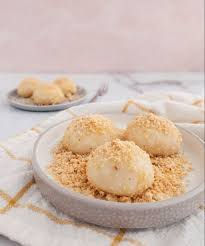Butterfly Pea Peanut Blue Mochi
- My Blue Tea
- Jun 26, 2020
- 3 min read
TRENDING ON IG !! Everyone wants Butterfly Pea Peanut Blue Mochi recipe
Wow! Never had so many requests for a recipe!
We published Butterfly Pea Blue Peanut Mochi today on Instagram and there were so many requests for recipes, yum oooo. Everyone loves it. Natural Blue colour is just gorgeous. And so is Catherine Ang, she made these and here's her recipe.
About Mochi
Mochi (Japanese: 餅, もち) is Japanese rice cake made of mochigome, a short-grain japonica glutinous rice, and sometimes other ingredients such as water, sugar, and cornstarch. The rice is pounded into paste and molded into the desired shape. In Japan it is traditionally made in a ceremony called mochitsuki. While also eaten year-round, mochi is a traditional food for the Japanese New Year and is commonly sold and eaten during that time.“
However, Mochi originated from China - China, being the forefather of the region, may have passed the tradition on to Japan at some point, having already passed many things to Japan early in history, like the written language, culture, architecture, dress, martial arts, and beliefs. The pounding process of making mochi originates from China, where glutinous rice has been grown and used for thousands of years. A number of Aboriginal Chinese tribes [clarification needed] have used this process as part of their traditions.
Some say that early Japanese settlers sailed over from China, or perhaps Mongolia. Mochi masters like the one in the video take pride in keeping such a tradition alive. Mochi production in Japan is believed to have began as far back as the Yayoi period, which started in 300 B.C.
The original mochi was made from nutrition-rich red rice. Because of its auspicious and divine connotations, it was only eaten by the emperor and by nobility. It also came to be used in religious ceremonies as offerings to gods.
Though Japan is famous for mochi, you will also find excellent mochi in Taiwan. Taiwan is so crazy about mochi that there is even a "Taiwan Mochi Museum" that moonlights as a mochi factory. Japan ruled Taiwan for a period of 50 years starting in the late 1800s. Even so, history is a complicated thing, and Taiwanese mochi makers may have brought some of that tradition over from Mainland China, as China also has a tradition of eating a glutinous rice-based food similar to mochi.
With the lockdown and closure of borders, it's a bit challenging to visit either Mochi Museum or Japan and we have Catherine to thank for this beautiful and yummy peanut Butterfly Pea Mochi recipe. If you are allergic to peanut, you may substitute the fillings with (a) Azuki beans or red beans (b) Pandan Coconut palm sugar (c) Durian (d) Purple Sweet Potato / Ube (e) or maybe even deep fry these mochis. Enjoy!
Ingredients for skin:
* 300g glutinous rice flour
* 50g wheat starch
* 75g caster sugar
* 1 1/2 tbsp oil
* 450ml water
* 1/2 tspn @my.blue.tea Butterfly Pea Powder
OR ( add enough Blue Butterfly Pea powder with the water to achieve the colour you desire)
Peanut filling (mix together):
* 300g blended roasted peanuts
* 100g caster sugar
* 1/4 tsp salt
Flour for coating & dusting:
* 200g rice flour, fried for 20 min over medium heat.
METHOD :
Step 1. Mix all ingredients until well combined. Sieve and pour into a greased steaming tray and steam over medium heat for 25 min.
Step 2. When the rice flour mixture is cool enough to handle, scrape it out onto a work surface scattered lightly with the dusting flour (per above).
* Divide cooking dough into small portion, about 35-40g each using sharp knife dusted in flour.
* Working with one piece at a time and dusting your hands with flour to stop it sticking, roll each piece into a ball.
* Flatten the ball then use your hands to form it into a round 8 cm across.
* Place a tablespoon of the filling in the centre of the round then bring the edges over the filling to enclose, pinching them together well to seal.
* Gently re-roll into a round, pressing the top slightly to flatten a little.
* Coated the Mochi with flour to smoothen the surface. Mochi will keep stored in an airtight container for up to 2 days.
ABOUT CATHERINE ANG :-
Another winning recipe by Catherine. We wish to thank Catherine who has been sharing a lot of recipes and beautiful photos of her creations. In her words, she loves baking and not good a cook. She's a specialist psychologist during the day and bakes during the weekend.
And if you would like to be featured here, do get in contact with us or email - info@mybluetea.com.au
Sources :








Comments